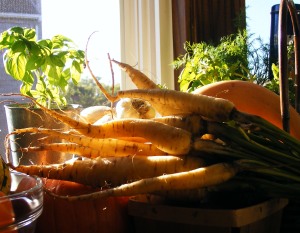
Last week I came home absolutely giddy because I had finally taken the plunge and signed onto the CSA program. Perplexed by my announcement, my boyfriend thought I was admitting to be a secessionist. Not quite. In the 21st century “CSA” more commonly refers to Community Supported Agriculture, and can basically be described as a network that connects consumers (of food) with the local farming community (take that Jefferson Davis!)
The way most CSA programs work involves “shareholders” or “subscribers” buying into a crop before the growing season begins. In return for the investment, consumers are supplied with a share of fruit and vegetables that the farm produces, which is chosen by the farmers based on which crops have ripened. Depending on the farm, they often deliver to neighborhood businesses, institutions, or even established subscribers’ homes. Shares of different sizes and intervals are available. For instance, from the church two blocks from my apartment, I will be receiving a share every other week, (as I only need enough for two people), over a 20-week span. Usually the growing season begins in June and lasts through September, sometimes with extensions into Fall and Winter. CSA involves more than produce farmers, but also meat and poultry, eggs and cheese, even nuts and flowers.
The value of establishing grower/consumer relationships through networks like CSA is enormous and beneficial to both parties. You can know exactly what you are eating, where it is from, and the conditions in which it was grown. Local food tastes better as it is more fresh and seasonable, with no need for long-term storage and over-packaging. Pollution is reduced by food traveling minimal distances, and farmland remains farmland, resisting needless urban and suburban sprawl. A step up from frequenting farmers’ markets, the grower is paid in advance, and energy is focused on food over fundraising.
I wanted to sign up last year but did not think I could afford it and was wary of moving apartments and being without a kitchen. So this is the year when I can test all the good things I’ve read—the only complaint I’ve come across is that there are too many vegetables, and you have to get creative cooking things you may not know about.
One of the struggles I never foresaw about urban living is the loss I often feel in not being a part of a tight-knit community. Growing up my world was small, as I’m sure it was for everyone, but it always felt like the people around me were there for a reason, that we all shared something much greater than proximity. I didn’t know what an advantage I had being raised within walking distance of Fairview Gardens, which remains today one of the finest small-scale urban food sites. Knowing now that my summer meals will be based on fresh food that came from southern Wisconsin and benefited a wonderful and underappreciated part of the community, for me, will be the best damn part of the summer



